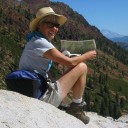The Geology of Crater Lake National Park
Like most of our national parks, the spectacular beauty of Oregon's only national park is a result of the geologic processes that created it. But whereas most of our parks were created by gradual processes over long periods of time—for example, erosion by the Colorado River to create the Grand Canyon—Crater Lake was created in a few days during a...
South Sister—the third highest volcano in Oregon and one of its youngest
The Three Sisters volcanoes, located in the Three Sisters Wilderness west of Bend, Oregon, are part of the Cascade Range of volcanoes formed above the Cascadia subduction zone. "For magnificence of glacial scenery, for wealth of recent lavas, and for graphic examples of dissected volcanoes, no part of this range surpasses the area embracing the Sisters and McKenzie Pass", said...
Lassen Volcanic National Park—the southernmost Cascade Range volcano
The Cascadia Subduction zone extends along the entire coast of Washington and Oregon, but also along the northern coast of California. South of Mendocino, California, the plates change from converging with each other (the ocean plate loses and slides beneath the continental plate in the subduction zone) to sliding past each other along the San Andreas fault (a transform-type plate...
How does the Rogue Valley fit into the larger tectonic picture?
In the last three posts, we explored the geologic makeup of the Rogue Valley region. Most people know that there is a subduction zone off the coast of the Pacific NW and you might wonder: how does the Rogue Valley region fit into this larger picture? We will explore the tectonic setting in this post. This diagram shows the present...
Sedimentary rocks tell stories about the Rogue Valley region’s geologic history
In the previous two posts, we explored the distribution of rock units in the Rogue Valley region, and how the different resistances of these rock types to weathering and erosion has created the topographic variations we see in the landscape. The different rock types also produce a large variety of soil types that are important for gardeners and vintners in...
Why is the Rogue Valley a valley?
In the April 19 post, we examined the geologic units that are exposed in the Rogue Valley region, and saw that the units are all tilted toward the NE, with the oldest units located to the SW (between the valley and the coast), and the younger units located toward the NE (toward the active volcanoes of the High Cascades like...
The Rogue Valley region in SW Oregon: displaying 300 million years of geologic time
Typically, I post blogs when traveling away from my home in Ashland, Oregon. But with COVID-19 keeping us all at home, it seems a good time to investigate the landscape of my local region. Ashland is a tourist town best known as the home of the Oregon Shakespeare Festival (OSF), an eight-month season of 11 plays—four by Shakespeare and seven...
Trekking through Cinque Terre turbidites
Cinque Terre National Park, with its five charming villages clinging to steep rocky slopes along the edge of the turquoise-colored Ligurian Sea, is a wildly popular tourist destination. For example, here is the southernmost town of Riomaggiore. Below is a map of the five villages, with the protected park area in a darker green color. The Cinque Terre is located...
The Famous Marble from Carrara Italy
Carrara marble is known worldwide because its pure white color makes it highly sought after for sculpture and ornamental work. Perhaps most famously, Michelangelo made his David and Pietà statues out of Carrara marble. The David statue was by accident—he acquired the piece of Carrara marble when it was rejected by another artist. After that he went to Carrara and...
Traversing the Swiss Alps on the Haute Route—the eastern end
After three days of traversing steep rocky passes in the cold and snow, we were ready for warm, clear weather and green valleys with quaint Swiss villages. The last snowy impediment was the Pas de Chévres, which was a little intimidating because of its vertical steel ladders. But by the time we had crossed over the glacier east of Cabane...
Traversing the Swiss Alps on the Haute Route—the middle section
Continuing eastward on the Haute Route is a roller-coaster trek of long uphills and downhills, with great expectations about what type of landscape will appear after topping the next pass and then what little village will lie in the valley at the bottom. In general, lodging in the valleys is in small hotels; in some parts, the route stays high...
Traversing the Swiss Alps on the Haute Route—the western end
The Haute Route was established as a route for skiers but is now also very popular for hikers in the summer. The route extends from Chamonix (France) to Zermatt (Switzerland). There are many variations on the route; most people choose a 7–14 day transect that could include "short cuts" of chair lifts, trains and/or buses. The map below (from https://www.pinterest.com/pin/205828645448998187/)...
About the Blogger
 Karen (here with Mt. Shasta in background) is a geology professor emerita who aims to provide a "pocket geologist" for world travelers. Follow the blog to explore the landscapes of our planet and figure out what causes them to look the way they do.
Karen (here with Mt. Shasta in background) is a geology professor emerita who aims to provide a "pocket geologist" for world travelers. Follow the blog to explore the landscapes of our planet and figure out what causes them to look the way they do.













